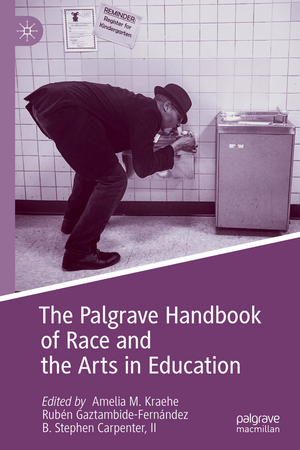The Palgrave Handbook of Race and the Arts in Education
Editat de Amelia M. Kraehe, Rubén Gaztambide-Fernández, B. Stephen Carpenter IIen Limba Engleză Hardback – 24 iul 2018
| Toate formatele și edițiile | Preț | Express |
|---|---|---|
| Paperback (1) | 2487.57 lei 6-8 săpt. | |
| Springer International Publishing – 26 ian 2019 | 2487.57 lei 6-8 săpt. | |
| Hardback (1) | 2492.78 lei 6-8 săpt. | |
| Springer International Publishing – 24 iul 2018 | 2492.78 lei 6-8 săpt. |
Preț: 2492.78 lei
Preț vechi: 3039.98 lei
-18% Nou
Puncte Express: 3739
Preț estimativ în valută:
477.07€ • 493.84$ • 403.22£
477.07€ • 493.84$ • 403.22£
Carte tipărită la comandă
Livrare economică 06-20 martie
Preluare comenzi: 021 569.72.76
Specificații
ISBN-13: 9783319652559
ISBN-10: 3319652559
Pagini: 657
Ilustrații: XXI, 599 p.
Dimensiuni: 155 x 235 x 38 mm
Greutate: 1.09 kg
Ediția:1st ed. 2018
Editura: Springer International Publishing
Colecția Palgrave Macmillan
Locul publicării:Cham, Switzerland
ISBN-10: 3319652559
Pagini: 657
Ilustrații: XXI, 599 p.
Dimensiuni: 155 x 235 x 38 mm
Greutate: 1.09 kg
Ediția:1st ed. 2018
Editura: Springer International Publishing
Colecția Palgrave Macmillan
Locul publicării:Cham, Switzerland
Cuprins
Chapter 1. The Arts as White Property
Chapter 2. Histories of Race and Racism in the Arts in Education: Colonialisms, Subjectivities, and Cultural Resistances
Chapter 3. White Subjectivities, the Arts, and Power in Colonial Canada: Classical Music as White Property
Chapter 4. Representations of Whiteness in Finnish Visual Culture
Chapter 5. Margaret Trowell's School of Art: Or How to Keep the Children's Work Really African
Chapter 6. Competing Narratives: Musical Aptitude, Race, and Equity
Chapter 7. And Thus We Shall Survive: The Perseverance of the South Side Community Art Center
Chapter 8. Counterstorytelling in Concert Dance History Pedagogy: Challenging the White Dancing Body
Chapter 9. African Dance as Epistemic Insurrection in Postcolonial Zimbabwean Arts Education Curriculum
Chapter 10. Discursive Materials of Racism and the Arts in Education: Narratives, Performances, & Material Culture
Chapter 11. Whitespeak: How Race Works in South African Art Criticism Texts to Maintain the Arts as the Property of Whiteness
Chapter 12. Race, Whiteness and the National Curriculum in Art: Deconstructing Racialized Pedagogic Legacies in Postcolonial England
Chapter 13. Toward a Counter-visual Education: Cinema, Race, and the Reorientation of White Visuality
Chapter 14. Empire Archaeologies: The Symbolic Interaction of Stereotype and New Self-Representation
Chapter 15. Dying of Thirst: Kendrick Lamar and the Call for a “New School” Hip Hop Pedagogy
Chapter 16. This Rock Will Not Be Forgotten: Whiteness and the Politics of Memorial Art
Chapter 17. Art Education and Whiteness as Style
Chapter 18. Lived Practices of Race and Racism in the Arts: Schools, Communities, and Other Educational Spaces
Chapter 19. Musicking Marginalization: Periphractic Practices in Music Education
Chapter 20. The Politics of Representation: Reconstructing Power and Privilege through Art
Chapter 21. Where is the Color in Art Education?
Chapter 22. Naming Whiteness in a High School Drama Program: A Youth Participatory Action Research (YPAR), Theatrical Inquiry into Whiteness
Chapter 23. Navigating “Crooked Rooms”: Intersections of Race and Arts Participation
Chapter 24. Children’s Westernized Beauty Ideals in China: Notions of Feminine Beauty
Chapter 25. Un-disciplined Racial Subjects in the Arts in Education: Cultural Institutions, Experiences, and Reflexive Interventions
Chapter 26. Decentering Whiteness and Undoing Racism in Art Museum Education
Chapter 27. Owners of Dance: How Dance is Controlled and Whitewashed in the Teaching of Dance Forms
Chapter 28. Investigating Multiracial Identities through Visual Culture: Counternarratives to Traditional Race Discourses in Art Education
Chapter 29. A Choral “Magical Hero”: A Lived Experience of Conducting Choirs in Canada
Chapter 30. Smog in the Air: Passive Positions, Deracialization, and Erasure in Arts Education
Chapter 31. The white noise of music education: Unsounding the possessive logic of patriarchal white sovereignty in the Australian curriculum
Chapter 32. What’s Wrong with this Picture? Interrogating Landscapes of Inequity in Art Education
Chapter 33. Tendus And Tenancy: Black Dancers and the White Landscape of Dance Education
Notă biografică
Amelia M. Kraehe is Associate Professor of Art and Visual Culture Education at the University of Arizona, USA
Rubén Gaztambide-Fernández is Associate Professor of Cultural Production and Curriculum Studies at the Ontario Institute for Studies in Education of the University of Toronto, Canada.
B. Stephen Carpenter, II is Professor of Art Education and African American Studies at The Pennsylvania State University, USA.
Textul de pe ultima copertă
The Palgrave Handbook of Race and the Arts in Education is the first edited volume to examine how race operates in and through the arts in education. Until now, no single source has brought together such an expansive and interdisciplinary collection in exploration of the ways in which music, visual art, theater, dance, and popular culture intertwine with racist ideologies and race-making. Drawing on Critical Race Theory, contributing authors bring an international perspective to questions of racism and anti-racist interventions in the arts in education. The book’s introduction provides a guiding framework for understanding the arts as white property in schools, museums, and informal education spaces. Each section is organized thematically around historical, discursive, empirical, and personal dimensions of the arts in education. This handbook is essential reading for students, educators, artists, and researchers across the fields of visual and performing arts education, educational foundations, multicultural education, and curriculum and instruction.
Caracteristici
Includes an international line-up of contributors from Uganda, Switzerland, Canada, Australia, South Africa, the UK, and the US
Uses a variety of theoretical approaches, most notably CRT, to examine how whiteness and white supremacy manifest, and are legitimated, through discourses, visual representations, and practices of the arts in education
Editors are internationally recognized scholars in the field
Uses a variety of theoretical approaches, most notably CRT, to examine how whiteness and white supremacy manifest, and are legitimated, through discourses, visual representations, and practices of the arts in education
Editors are internationally recognized scholars in the field
